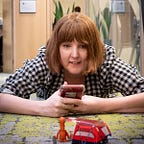Service Design Training with Experience Haus — Weeks 1 and 2
Documenting my experiences on this 12 week course which takes place 2 nights a week.
I recently left my role as Associate Director at Social Finance via voluntary redundancy. As part of this change I decided that I would look to use my skills in a service design role. While I have a raft of experience and seniority, I wanted to use some of my upcoming free time to undertake additional training with a focus on certain practical elements and support to create a portfolio so that I can brush up my existing skills and build my confidence.
As part of this training I plan to blog about the work along the way because when you ‘make things open it makes things better’.
If you want to know what this course covers I’ve copied the syllabus below, and you can find out more on the Experience Haus website.
The cohort is made up of 6 of us and I was delighted when I realised that Imran Hussain was in this cohort with me. There are a range of backgrounds and various levels of experience but everyone has some experince of some of the tools or approaches. It’s led by Daniel Souza who has been facilitating expertly and taking the time to explain everything, make sure everyone has the opportunity to contribute.
Unfortunately, due to an onboarding mix up I missed the first two sessions in the first week and will miss tomorrow’s session too due to a prior commitment, but recordings let me keep up and I’m mostly interested in the practical work at later stages in the training anyway. We also have a cohort slack channel.
Session 1 was focused on everyone getting to know each other, and on an introduction to service design generally, featuring the double diamond as an approach for understanding convergence and divergence. Session 2 was a bit of an overview of thinking about freeform ecosystem or relationship maps. Generally I feel pretty confident in these areas.
I finally was able to make Session 3 where we reviewed a real world brief from a stakeholder. We had some time to individually interrogate the brief and then spent some time getting down as many questions as possible that we had about the brief. We then did some affinity mapping to start to organise questions we want to ask of the client when we meet them next week. So session 4 and homework will be to develop a discussion guide.
I have a lot of experience of affinity mapping and dot voting as this is kind of bread and butter for collaboration work, so this was pretty easy for me but we are also using Figma (which I have wanted to learn for some time because, I dunno, it’s the sort of de facto) and FigJam for brainstorming and workshopping is getting me into a muddle as I’ve been using Miro for so long my muscle memory is making things difficult. Would be great if all of these products agreed on an interface approach, that would make it so much easier for me ;)
Anyway the brief is really interesting, it’s for an eco-conscious vegetable delivery service who want to take a product nationally. The question-storming was useful because everyone had different approaches to questioning the brief. I found that most of my questions were predominantly on the users (customers) and on the operational aspects of the brief (how might things actually happen or work in practice) while others focused more on the USP of the product or sustainability elements. It’s a good reminder of the need for differing perspectives in this kind of work. I’m keen to see how the discussion guide pulls together and to find out more about this work because it has a private sector focus and will mean I can take a different angle on what I think I currently know.
Generally so far I don’t think I’ve learned too much over and above what I already know, but that’s kind of good in a way because it’s useful to reflect on what I know and reinforce some of it to build my confidence and I deliberately chose this course as a way to go slightly backwards to go forwards.
I’m going to miss Session 4 tomorrow, but I’m sure the cohort will do a good job of sorting through the questions, and I’ll be able to contribute to the discussion guide. Next week we start to work with the client and I’m sure things will start to pick up — I’m looking forward to that. Onwards.
I’m Sam and I’m a service designer looking for a new role. If you want to find out more about me you can visit:
